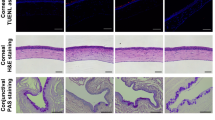Summary
The involvement of substance P (SP) in the antidromic vasodilation, neurogenic plasma extravasation and disruption of the blood-aqueous barrier has been investigated in the rabbit eye. The distribution, inactivation and effects of exogenous SP in the anterior uvea after injection into the anterior chamber were studied and the results were compared with data obtained on endogenous SP. About 2% of intracamerally injected 125I-tyr-8-SP was recovered from the ciliary processes. Out of this 1–3% was found to be biologically active. Thirteen to 24% of endogeneous SP in the anterior uvea was detected in the ciliary processes. Intracameral injection of 50–100 μg SP in indomethacin pretreated rabbits had practically no effect on ocular blood flow, capillary permeability to Evans blue or the bloodaqueous barrier. Continuous infusion of 0.8–4.0 μg/min SP for 30 min into the common carotid artery had no significant effect on capillary permeability or the blood-aqueous barrier. In contrast to these findings, nociception accomplished with topical application of 1% neutral formaldehyde for 4 min in indomethacin pretreated rabbits induced a marked increase in blood flow in the anterior uvea plasma extravasation, disruption of the blood-aqueous barrier and an increase in the intraocular pressure. These effects could not be blocked by the SP antagonist analog (d-Pro2, d-Phe7, d-Trp9)-SP. The topical pulse treatment with formaldehyde, although inducing longlasting irritation, did not significantly decrease the amount of endogenous SP in the anterior uvea as studied 30–60 min after application of the irritant. It is concluded that in the rabbit anterior uvea, which is practically devoid of mast cells, it is questionable whether SP is causatively involved in the antidromic vasodilation, neurogenic plasma extravasation and disruption of the blood-aqueous barrier. The same may also be true for the nonhistaminergic part of the corresponding vascular responses in the skin.
Similar content being viewed by others
References
Alm A, Bill A (1972) The oxygen supply to the retina. II. Effects high intraocular pressure and of increased arterial carbon dioxide tension on uveal and retinal blood flow in cats. Acta Physiol Scand 84:306–319
Bill A, Stjernschantz J, Mandahl A, Brodin E, Nilsson G (1979) Substance P: Release on trigeminal nerve stimulation, effects in the cyc. Acta Physiol Scand 106:371–373
Bradford MM (1976) A rapid and sensitive method for the quantitation of microgram quantities of protein utilizing the principle of proteindyc binding. Anal Biochem 72:248–254
Butler JM, Hammond BR (1980) The effects of sensory denervation or the responses of the rabbit eye to prostaglandin E1, bradykinin and substance P. Br J Pharmacol 69:495–502
Butler JM, Unger WG, Hammond BR (1979) Sensory mediation of the ocular response to neutral formaldehyde. Exp Eye Res 28:577–589
Butler JM, Powell D, Unger WG (1980) Substance P levels in normal and sensorily denervated rabbit eyes. Exp Eye Res 30:311–313
Camras CB, Bito LZ (1980) The pathophysiological effects of nitrogen mustard on the rabbit eye. II. The inhibition of the initial hypertensive phase by capsaicin and the apparent role of substance. Invest Ophthalmol Vis Sci 19:423–428
Chubb IW, Hodgson AJ, White GH (1980) Acetylcholine esterase hydrolyzes substance P. Neuroscience 5:2065–2072
Cole DF (1974) The site of breakdown of the blood-aqueous barrier under the influence of vasodilator drugs. Exp Eye Res 19:591–607
Hökfelt T, Johansson O, Ljungdahl Å, Lundberg JM, Schultzberg M (1980) Peptidergic neurons. Nature 284:515–521
Jampol LM, Neufeld AH, Sears ML (1975) Pathways for the response of the eye to injury. Invest Ophthalmol 14:184–189
Laties A, Jacobowitz D (1964) A histochemical study of the adrenergic and cholinergic innervation of the anterior segment of the rabbit eye. Invest Ophthalmol 3:592–600
Leander S, Håkanson R, Rosell S, Folkers K, Sundler F, Törnquist K (1981) A specific substance P antagonist blocks smooth muscle contractions induced by non-cholinergic, non-adrenergic nerve stimulation. Nature 294:467–469
Lembeck F, Holzer P (1979) Substance P as the neurogenic mediator of antidromic vasodilation and neurogenic plasma extravasation. Naunyn-Schmiedeberg's Arch Pharmacol 310:175–183
Lembeck F, Donnerer J (1981) Time course of capsaicin-induced functional impairements in comparison with changes in neuronal substance P content. Naunyn-Schmiedeberg's Arch Pharmacol 316:240–243
Nicoll RA, Schenker C, Leeman SE (1980) Substance P as a transmitter candidate. Ann Rev Neurosci 3:227–268
Smelser GK, Silver S (1963) The distribution of mast cells in the normal eye. A method of study. Exp Eye Res 2:134–140
Stjernschantz J, Sears M, Stjernschantz L (1981) Intraocular effects of substance P in the rabbit. Invest Ophthalmol Vis Sci 20:53–60
Stjernschantz J, Gregerson D, Bausher L, Sears M (1982) Enzyme-linked immunosorbent assay of substance P. A study in the eye. J Neurochem 38:1323–1328
Teichberg VI, Blumberg S (1980) Substance P receptors. In: Schulster D, Levitzki A (eds) Cellular receptors for hormones and neurotransmitters. John Wiley Sons, Chichester New York Brisbane Toronto, pp 397–403
Tervo K, Tervo T, Eränkö L, Eränkö O, Cuello AC (1981) Immunoreactivity for substance P in the Gasserian ganglion, ophthalmic nerve, and anterior segment of the rabbit eye. Histochem J 13:435–443
Törnquist K, Mandahl A, Leander S, Loren I, Håkanson R, Sundler F (1982) Substance P immunoreactive nerve fibers in the anterior segment of the rabbit eye: Distribution and possible physiologic significance. Cell Tissue Res (in press)
Unger WG, Cole DF, Hammond B (1975) Disruption of the bloodaqueous barrier following paracentesis in the rabbit. Exp Eye Res 20:255–270
Author information
Authors and Affiliations
Rights and permissions
About this article
Cite this article
Stjernschantz, J., Sears, M. & Mishima, H. Role of substance P in the antidromic vasodilation, neurogenic plasma extravasation and disruption of the blood-aqueous barrier in the rabbit eye. Naunyn-Schmiedeberg's Arch. Pharmacol. 321, 329–335 (1982). https://doi.org/10.1007/BF00498522
Received:
Accepted:
Issue Date:
DOI: https://doi.org/10.1007/BF00498522




